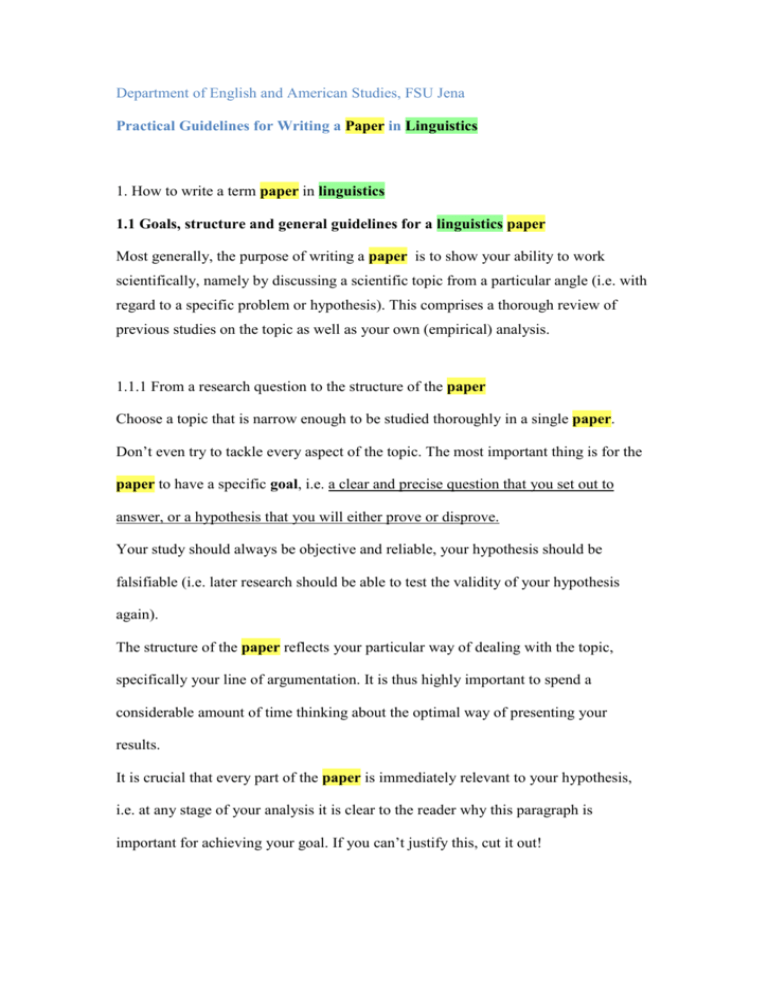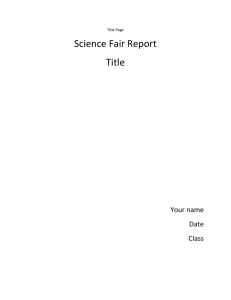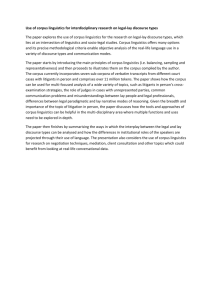Department of English and American Studies, FSU Jena Practical
advertisement

Department of English and American Studies, FSU Jena Practical Guidelines for Writing a Paper in Linguistics 1. How to write a term paper in linguistics 1.1 Goals, structure and general guidelines for a linguistics paper Most generally, the purpose of writing a paper is to show your ability to work scientifically, namely by discussing a scientific topic from a particular angle (i.e. with regard to a specific problem or hypothesis). This comprises a thorough review of previous studies on the topic as well as your own (empirical) analysis. 1.1.1 From a research question to the structure of the paper Choose a topic that is narrow enough to be studied thoroughly in a single paper. Don’t even try to tackle every aspect of the topic. The most important thing is for the paper to have a specific goal, i.e. a clear and precise question that you set out to answer, or a hypothesis that you will either prove or disprove. Your study should always be objective and reliable, your hypothesis should be falsifiable (i.e. later research should be able to test the validity of your hypothesis again). The structure of the paper reflects your particular way of dealing with the topic, specifically your line of argumentation. It is thus highly important to spend a considerable amount of time thinking about the optimal way of presenting your results. It is crucial that every part of the paper is immediately relevant to your hypothesis, i.e. at any stage of your analysis it is clear to the reader why this paragraph is important for achieving your goal. If you can’t justify this, cut it out! Remember that the internal structure of the main parts of your paper also reflects the way you weight the different aspects of your topic! 1.1.2 Studying research literature you only have to concentrate on those aspects that are immediately relevant to your own study! Don’t summarise and discuss unnecessary aspects of the literature in order to ‘fill pages’. Here are some important questions you may wish to consider while reading research literature: 1. What does the text deal with exactly? 2. What’s the specific perspective from which the topic is considered? 3. What’s the author’s method of tackling the question? 4. What’s the structure of the text? How does it reflect the author’s line of argumentation? 5. What are the central hypotheses and findings? 6. Do these findings point to further research? Are there any open questions? 1.1.3 Structure of the paper Minimally (though prototypically), your paper should contain an introduction, a main body and a concluding section. Introduction Why do you conduct this study? What makes it interesting? What is your goal? (Short statement of purpose.) Delimit the topic and formulate a precise research question and/or a hypothesis. Outline your methodological approach to answering this question. (e.g. Are you using corpus data, questionnaires, reference grammars, other data material, comparative secondary literature, etc.) Main body describes in detail the linguistic phenomenon you investigate includes a review of previous research on your question or on the topic presents in detail your own analysis and your results in an appropriate way (this may include graphical illustrations, table, figures etc.) [Notice that while the introduction and the conclusion usually each form a section of the paper (e.g. 1. Introduction, 5. Conclusion), the main body typically stretches over several sections, each of which comes with its individual headline.] Conclusion Refer back to your introduction: take up the goal of the study and your hypothesis again. Briefly summarise your findings. Indicate what you haven’t been able to discuss, i.e. point to potentials for future research. Again, never lose sight of the goal of your investigation and your specific research question! The paper is framed by a table of contents and a bibliography (list of all the references you have cited in the text, see below). If you wish to include some more comprehensive data in your paper, you may create an appendix after the main text. Once you have finished, have someone else proofread your paper (in addition to carefully proofreading it yourself, of course)! 1.2 Advanced research: Structure of an empirical research paper At a more advanced stage of your studies (notably at the M.A. level), you may be set to the task of conducting your own empirical analysis, i.e. gathering, analysing and interpreting a fairly large amount of authentic data, for example from first language acquisition. In these cases, the structure of the paper is necessarily more elaborate than above: A. Introduction 1. Background and preview Why do you conduct this study? What makes it interesting? Short statement of purpose/hypothesis. 2. Linguistic phenomenon Describe the linguistic phenomenon you investigate (e.g. relative clauses, resultative construction): define the category, describe its features (e.g. inflectional variation, word order variation), give examples. 3. Literature review If there are previous studies, summarize the main findings and say what you intend to do in your study based on previous work (e.g. look at a particular phenomenon that has not been investigated thus far; challenge a previous hypothesis; replicate a previous study to see if the results of that study carry over to other data; etc.). If there are no previous studies, make that clear: “This is the first study to investigate ….” 4. Preview / explicit hypothesis State your hypothesis (or hypotheses) and if necessary explain it/them in more detail. This may include a preview of your most important results. B. Method 1. Subjects, corpus, and materials Describe the data you investigate. If you conduct an experimental or questionnaire study, characterize your subjects and describe the materials you have used. If you conduct a corpus study, characterize the corpus (e.g. size, kind). You may want to include summary tables of your data, but don’t present the results of your analysis at this stage. 2. Procedure Describe the way you have collected the data. How did you conduct the experiment? How did you search for particular constructions in the corpus? 3. Coding Describe how you have categorized the data. Give an overview of all categories and state how you assigned a particular response (in an experimental study) or a particular instance (in a corpus study) to a particular category. 2. Inferential statistics: Once you have described your data, submit them to statistical analysis. Say what type of test you have used and present the relevant measures (e.g. p-value, F-value, degrees of freedom, effect size, confidence intervals). If it is not obvious why you used a particular test, explain your decision, but don’t describe obvious choices (e.g. I have used a chi-square test because the data are frequency data). Say also what the statistical analysis suggests, i.e. how the results should be interpreted. C. Results 1. Descriptive summary of results (i) In the social sciences (e.g. psychology, sociology) you first present your results and then discuss them. In linguistics, the results and the discussion are often combined in one section, but if you find it appropriate you can separate them. (ii) Present tables and figures to summarize your findings, but don’t present your findings twice, i.e. first in a table and then in a figure. (iii) Preparing tables and figures can be difficult. Don’t give long tables including hundreds of numbers; nobody has the time to look at them. The tables and figures in the text serve to provide easy access to your most important findings. The appendix may include a more detailed summary of your results presented in more comprehensive tables. (iv) You need to discuss the results presented in tables and figures! The figures/tables alone are not sufficient. Say what the descriptive statistics suggest. D. Discussion 1. Provide a short summary of your results 2. Theoretical implications: If possible consider your paper from a broader theoretical perspective and mention implications of your study for related questions. 1. Future direction of research: Mention open questions: What should be done in the step? Ideas for an experiment. Etc. Appendix If the data are too comprehensive to be included in the text, include them in the appendix. If the data are very comprehensive, you might only present parts of your data in the appendix. References List all articles and books you have cited (see below). 2. Style sheet – Standard format of a linguistics paper and citation conventions 2.1 Questions of style In general, your style of writing the paper is as important as the contents. You should always aim at the clearest possible way of presenting your study, i.e. keep your words relatively simple (‘scientific’ does not mean ‘stylish’, ‘particularly complex’ or ‘rhetorically elaborate’!). Get rid of every line that you can dispense with: “If it is possible to cut a word out, always cut it out.” (Orwell 1947) Be absolutely precise and consistent in your use of terminology! Define relevant terms when they first occur, and use them consistently throughout the entire paper. It is not ‘bad style’ at all to use the same scientific words multiple times, so refrain from using synonyms that potentially lead to confusion. 2.2 Layout and typographic conventions In terms of layout, a common standard is a word-processed document with a 11-12pt font size, 2.5cm margins and a 1.5 space between lines. Justify the flow of the text (Blocksatz; this holds for the main text, all footnotes as well as for the list of references at the end!). Avoid the use of unnecessary emphasis in the form of underlining, bold marking or italics. Note that these have conventional uses: You may underline a word, phrase or passage in a direct quote in order to emphasise it, but you have to state that you added the emphasis: You may use bold markings for highlighting particularly important parts of your examples. Use italics for book titles (e.g. Words in the Mind) and for metalinguistic references, i.e. lexical items, phrases, constructions you discuss as examples: the word blue Label all your examples continuously using numbers, and put them in italics: (1) The man I saw on the street was talking to his neighbour. … (15) ni-tana'-chi:wa 1 S -basket-make 'I make baskets' Number your tables and figures as well: Table 4. Figure 2a. Note that all examples, tables and figures are numbered independently of one another. 2.3 Text-internal references to previous research Probably the most serious ‘crime’ in academics is to steal other people’s ideas, or what is commonly called plagiarism. It is important to know and to state what previous research has found out about the topic, but you have to make it explicit when you are referring to other people’s ideas, either by direct quotes or by paraphrasing their main findings or arguments: Direct quotes: “The historical processes of grammaticalization and syntactization derive from a number of psychological and social-communicative processes that have been well studied, most importantly automatization, functional reanalysis, and analogy.” (Tomasello 2003: 15) In general, avoid making your study an assembly of quotations by using too many of them! You should only fall back on a direct quote if it succinctly makes a point that contributes to your line of argumentation (or presents a counter-position that you intend to challenge). Also, try to avoid long quotations. As a rule of thumb, if a quote is longer than three lines, set it apart from the text (an extra paragraph, indented): Declerck describes the temporal schema of the Present Perfect as follows: [A] present perfect locates a situation in a period of time that starts before t and leads up to it. The situation located in this period can either lie entirely before t and lead up to (and include) t. In the former case the present perfect is said to have an ‘indefinite’ (‘existential’) meaning, in the latter it is ‘continuative’. (Declerck 1991: 28)It is thus clear that the Present Perfect differs in its temporal schema from the Simple Past (Preterite). Indirect references (‘sinngemäße Zitate’) According to Croft (2003: 59ff.), word order patterns in the languages of the world are shaped by competing motivations. Following Lakoff and Johnson (1980), I will argue that the concept of TIME is conceptualised and structured metaphorically in terms of orientation and movement in space. In my use of the term mental lexicon I follow Aitchison (2003: 9). In the following, I will outline the most prominent theories of second language acquisition. This survey is based on Mitchell and Myles (2004). In contrast to previous work (e.g. Chomsky 1969), I claim … I found that children do not seem to understand the use of infinitival complement clauses before the age of three (cf. Tavakolian 1977: 64). Avoid footnotes. All references within the text as well as the sources of direct quotes are made explicit in the text itself (author’s name: page). Use footnotes for the following: additional information that is useful to know but would disturb the smooth flow of the main text (e.g. additional references to secondary sources, contrary positions in the literature) further explications that enable a better understanding of terminology, quotations and minor aspects of the topic cross-references to statements of your own text (e.g. cf. §1.2 above). 2.4 References (bibliography) All references made in the text, i.e. all works cited or referred to in the text, are listed in alphabetical order at the end of the paper. This section is entitled References or Bibliography. Its outline and typography follows the general conventions of the MLA. Note that the citation conventions in linguistics differ slightly from those used in literary criticism. Therefore, stick to following examples: Monographs Comrie, Bernard (1985). Tense. Cambridge: Cambridge University Press. A paper in a collection of essays Cristofaro, Sonia (2005). “Purpose Clauses.” In: The World Atlas of Language Structures. Eds. Martin Haspelmath, Matthew S. Dryer, David Gil and Bernard Comrie. Oxford: Oxford University Press. 506-507. A book in a series Bybee, Joan (1985). Morphology. Typological Studies in Language IX. Amsterdam: John Benjamins. A journal article Dahl, Östen (1979). “Typology of Sentence Negation.” Linguistics 17: 79-106. An encyclopaedic reference article Ehlich, Konrad (2000). “Deixis.” In: Metzler Lexikon Sprache. 2nd ed. Ed. Helmut Glück. Stuttgart,Weimar: Metzler. 138-139. Some minor aspects: If a work is co-authored or co-edited by more than two authors, you are allowed to shorten its reference in the text (not in the bibliography) by using et al.: (Quirk et al. 1992) If two works of the same author were published in the exact same year, you differentiate them by small letters after the year of publication: (cf. Haspelmath 2005a), Nichols 1986b. Generally, there is, of course, some room for minor variations in these citation forms. What is important, however, is that you are consistent in your own way of citing all references. Department of English and American Studies, FSU Jena Practical Guidelines for Writing a Paper in Linguistics









